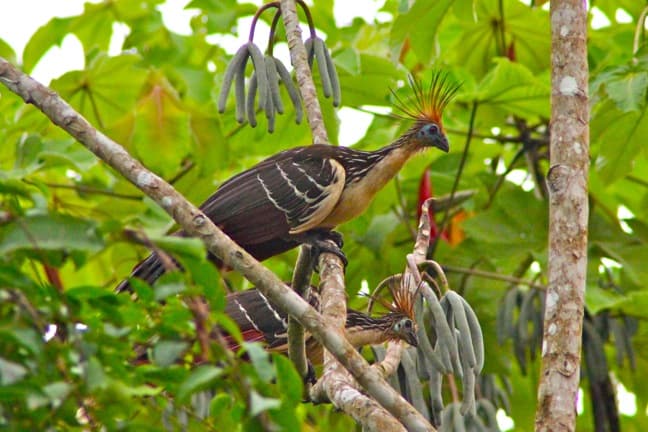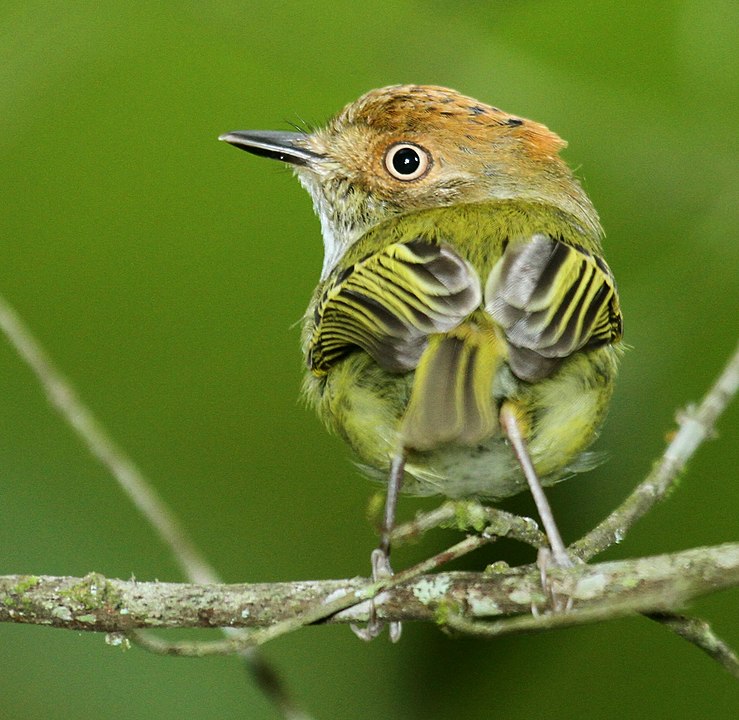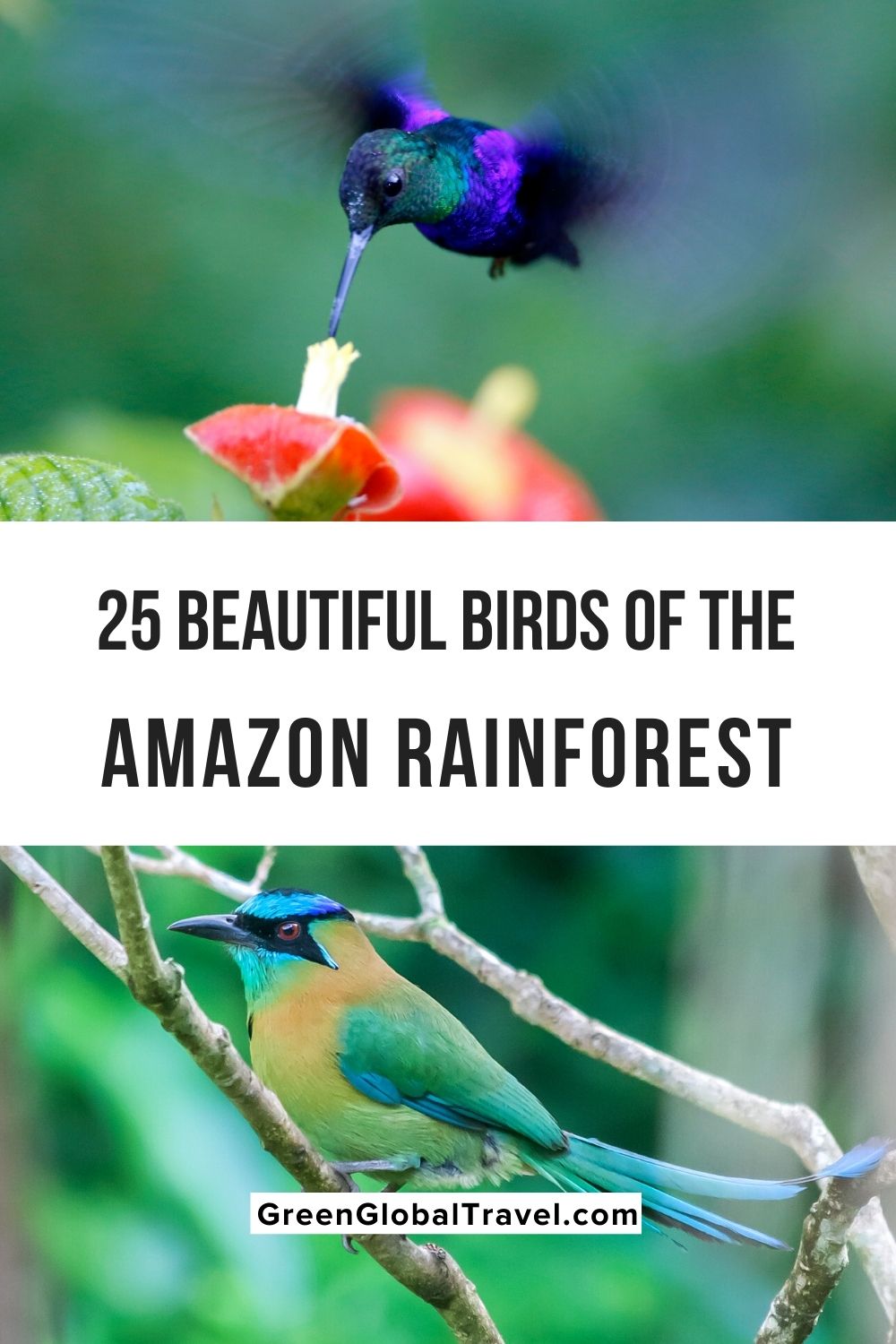With over 1,800 species, of which 139 are endemic, the birds of Peru are spectacularly diverse.
So it’s no surprise that the country has emerged as a favorite among people who love Amazon Rainforest Animals, especially birdwatchers.
Destinations such as Manu National Park, Colca Canyon, and the Islas Ballestas have all become increasingly popular ecotourism attractions in recent years.
Still, the Peruvian Amazon is arguably the country’s finest hotbed of incredible avian activity.
There were around 575 species of Amazon birds identified, just within one particular 5,500-hectare section of the rainforest.
By comparison, only 700 bird species are found in all of the forests in North America.
You could write an entire book about all the beautiful species avid birdwatchers could see during a week of exploring the biodiverse Amazon rainforest basin.
But here’s a brief guide to a few dozen beautiful birds in the Amazon Rainforest that you may be able to spot during a Peruvian Amazon river cruise.
READ MORE: 70 Cool & Weird Animals Around the World

Birds in the Amazon Rainforest Guide
- Amazon Kingfisher
- Black Collared Hawk
- Capped Heron
- Dusky Headed Parakeet
- Golden-Headed Manakin
- Grey-Headed Kite
- Guans
- Harpy Eagle
- Hoatzin
- Horned Screamer
- Hummingbirds
- Jabiru Stork
- King Vulture
- Macaws
- Motmots
- Parakeets/Parrots
- Potoos
- Puffbirds
- Scale-Crested Pygmy Tyrant
- Toucans
- Trogons
- Yellow-Headed Caracara

AMAZON KINGFISHER
Found throughout the American tropics from southern Mexico to northern Argentina, the Amazon Kingfisher looks like a larger version of the Green Kingfisher.
They can grow up to 12 inches long and three to four times as heavy.
They have oily green heads, shaggy crests, white collars, and lack the white wing markings of their green cousins.
Watch for them on rocks and branches close to the water, where they feed on fish and amphibians.
READ MORE: 35 Beautiful Birds of Hawaii and the Polynesian Triangle

BLACK COLLARED HAWK
Found in Central and South America as well as Trinidad & Tobago, this beautiful bird of prey inhabits subtropical or tropical moist lowland forests and subtropical or tropical swamps.
It can be identified by a white head tinged with buff, with black shaft streaks on the crown; a bright cinnamon-rufous body that grows paler on the chest, with a black crescent on the upper breast; a back with black shaft stripes; and black tail feathers barred with rufous.
You’ll often see them swooping down to feed on fish, small lizards, insects and rodents.
READ MORE: 20 Best Caribbean Islands to Visit (If you Love Nature & Hate Crowds)

CAPPED HERON
This colorful bird is found in many parts of Central America and South America, typically around rivers, swamps and freshwater lakes.
The Capped Heron is noteworthy for the brilliant blue and pink colors on its beak, bright yellow feathers on its neck and underbelly, and long, skinny plumes coming off its head, which make it look a little like a refined distant cousin to Africa’s famed Secretary Bird.
READ MORE: Animals in Kenya: A Guide to 40 Species of Kenyan Wildlife

DUSKY HEADED PARAKEET
A common sighting in both the Amazon and domestic bird cages, this verdant green, blue and grey neotropical parrot is also known as the Weddell’s conure or dusky-headed conure.
They prefer semi-open wooded habitats in the Western Amazon, but are also often seen in coffee plantations and in colonies around the Lima coast.
Social, energetic and entertaining, they tend to be found in pairs or small groups, feeding on fruit, seeds, flowers and insects.
READ MORE: 40 Amazing Costa Rica Animals

GOLDEN-HEADED MANAKIN
One of around 60 species of manakins found in the American tropics, the Golden-Headed Manakin is a colorful cutie typically measuring about 3.7 inches long and weighing less than half an ounce.
Females and juveniles look similar to female White-Bearded Manakins, but adult males are black-bodied with a golden cap, white and red thighs, pink legs and yellow bill.
Commonly found in low elevation forests and plantations, their jumping, sliding mating ritual and buzzing zit-zit call are a wonder to behold.
READ MORE: 25 Galapagos Birds You Can See on a Galapagos Cruise

GREY-HEADED KITE
This beautiful raptor species is found in open woodland and swamp-like forests ranging from eastern Mexico and Trinidad down to Peru, Bolivia and Argentina.
The adult has a grey head and legs, blue bill, black upper body, white underbelly, and a black tail with two or three white bars.
They are often spotted on high perches while hunting for reptiles, frogs and insects, with a striking profile and a distinctive mewling keow-sounding call.
READ MORE: Bolivian Amazon Wildlife

GUANS
Related to curassows, these turkey-like birds are found in the subtropical and tropical forests of northern South America.
There are two guan species you may see in the Peruvian Amazon.
The Spix’s Guan is named after German naturalist Johann Baptist von Spix and boasts brown feathers speckled with white and a vivid red wattle.
The Blue-throated Piping Guan is most black with a greenish shimmer, with white wing patches, white fleck on the chest, a white crest, and blue beaks and throats.
READ MORE: Top 15 Female Wildlife Conservationists & Animal Right Activists

HARPY EAGLE
Also known as the American Harpy Eagle to distinguish it from a similar species found in Papua New Guinea, this fearsome bird of prey is the largest and most powerful raptor in the Amazon rainforest.
Females are bigger than males, weighing up to 22 pounds and measuring up to 40 inches long, with a wingspan of six to seven feet.
They’ve got pale grey, double-crested heads; broad black breast bands; white bellies; slate black uppers; and black tails with three grey bands on top and three white bands below.
READ MORE: 30 Amazing Galapagos Islands Animals

HOATZIN
Also known as the Canje Pheasant (or punk-rock bird), Hoatzin are genetically enigmatic, and there’s been intense scientific debate about their evolutionary connections to other species.
The pheasant-sized weird bird, whose chicks possess claws on two of their wing digits, is also called the Stinkbird due to the manure-like odor caused by its unique digestive system.
Their noises are just as odd, including a bizarre variety of groans, croaks, hisses and grunts that are often associated with its body movements.
READ MORE: 30 Cool & Weird Ocean Animals Around The World

HORNED SCREAMER
These massive (around 3 feet long), odd birds may look like game birds, but they’re actually related to ducks, geese, and swans.
You’ll likely hear them before you see them: As the name suggests, they have a loud, echoing call.
Living in vegetated marshes, where they feed on water plants, Horned Screamers are mostly black with white specks.
The long, horn-like structure that sticking out of their crown is unique, loosely attached to the skull, and grows (and breaks) continuously.
READ MORE: 40 Fascinating Facts About the Hawaiian Gooses (a.k.a. Nene Goose)

HUMMINGBIRDS
If you love hummingbirds, the Peruvian Amazon offers more than a dozen dazzling species that are virtually guaranteed to delight.
Their gem-like colors encompass virtually every color of the rainbow.
Highlights include the blue crown and fuchsia neck of the Long-billed Starthroat, the vivid green of the aptly-named Glittering-throated Emerald, the striking royal purple breast of the Fork-tailed Woodnymph, and the shimmering aqua shades of the Blue-chinned Sapphire.
READ MORE: Indian Animals: A Guide to 40 Incredible Indian Wildlife Species

JABIRU STORK
The tallest flying bird in Central and South America, this species also has the continent’s second-longest wingspan (after the Andean Condor).
Found in the Americas from Mexico down to Argentina, east of the Andes Mountains, they’re typically found in large groups near rivers and ponds, where they spend much of their time feasting of fish, mollusks and amphibians.
Measuring four to five feet long, with black heads, white-feathered bodies and a vibrant red neck pouch, they make striking photo subjects.
READ MORE: Alaskan Animals: 40 Species you can see during your Alaska Vacation

KING VULTURE
There are four vulture species found in the Peruvian Amazon, but this colorful character deserves the crown for most beautiful.
With a range that covers much of Central and South America, these birds can be found in ancient hieroglyphic texts of the Pre-Colombian Maya civilization.
They’re large and predominately white, with grey to black tail feathers, an orange fleshy caruncle on the beak, and a colorful bald head that may include blue, orange, purple, red, and yellow.
READ MORE: The 16 Best Mayan Ruins to Explore

MACAWS
From Blue-and-Yellow and Scarlet Macaws to Green-Winged and Chestnut-Fronted Macaws, these New World parrots will easily rank among the most colorful birds you’ll see in the Peruvian Amazon.
More often than not you’ll hear them squawking loudly long before they come into sight, usually flying over in mating pairs.
You may also spot them in groups in the trees, feeding on seeds, nuts, fruits, leaves, flowers and stems.
READ MORE: Macaw Mountain, Honduras

MOTMOTS
Passerine birds related to Kingfishers and Bee-Eaters, these neotropical forest-dwellers.
These Amazon Birds are known for their colorful plumage, large bills and long tails (some with a racket-like tip) that they use for wagging at predators and, in the case of males, attracting mates.
Living in colonies of up to 40 paired individuals, Motmots typically nest in riverbank tunnels, and feed on everything from fruit and insects to frogs, lizards and other small prey.
READ MORE: 55 Interesting Facts about Elephants (for World Elephant Day)

PARAKEETS/PARROTS
Of all the Amazon bird species you might see during a small ship river cruise, few elicit more excitement than the dozens of colorful parakeet and parrot species.
Parakeets (whose name is derived from perroquet, the French word for parrot) are generally smaller and tend to breed in groups, but the words parrot and parakeet are often used interchangeably.
Amazon parakeet species include the grey face of the Dusky-headed Parakeet, the striking reds of the Maroon-tailed Parakeet, and the brilliant blues of the Cobalt-winged Parakeet.
As far as Amazon parrots go, they come Black-headed, Blue-headed, Blue-winged, Orange-cheeked, Orange-winged, White-bellied, and Yellow-crowned.
My favorite is the aptly-named Festive Parrot, whose face looks as if he’s just returned from an Indian Holi celebration.
READ MORE: 20 Best Festivals in the World

POTOOS
There are two species of potoos– the Common Potoo and the Great Potoo– found in the Peruvian Amazon.
But you’ll likely need an eagle-eyed naturalist guide armed with binoculars if you want to find them.
That’s because these owl-like birds (which are actually closely related to nightjars and frogmouths) are masters of camouflage.
Their disproportionally large heads and mottled brown and grey feathers allow them to spend the day perched on stumps or branches, with eyes half-closed, virtually unnoticeable with the naked eye.
At night, they use their huge eyes and massive mouths to feed, mostly on flying insects.
READ MORE: 40 Interesting Facts About Snow Leopards

PUFFBIRDS
Shy and secretive by nature, these tropical tree-dwelling insectivores can be found from Mexico down through South America.
But, with their preference for forested habitats, their greatest species diversity can be found in the Amazon Basin.
They may lack the iridescent colors of their cousins, the Jacamars, but the Puffbirds’ loose plumage, short tails, and brightly-colored bills and eyes give them undeniable appeal.
They rarely vocalize, preferring to sit still and quiet while waiting for insects on which to prey, but you might hear their repeated, high-pitched whistles at dawn and dusk.
READ MORE: 40 Fascinating Facts About the Amur Leopard

SCALE-CRESTED PYGMY TYRANT
The mascot of the Mongabay environmental science website, this adorable bird is found in tropical forests in Central America and the northern part of South America.
They’re tiny and difficult to see in the wild, as they prefer searching for food in the darker part of the forest.
But they’re beautiful birds, named for the crest of feathers that are usually only displayed when they’re attracting mates or trying to make themselves look bigger due to a threat.
READ MORE: 50 Fascinating Facts About Guatemalan Culture

TOUCANS
From the 11.5-inch tall Lettered Aracari to the 29-inch Toco Toucan, this family of around 40 different species can be found throughout Central and South America and generally rank among the most popular sightings in the Peruvian Amazon.
Perhaps it’s their bright markings and huge colorful bills, or perhaps it’s just the fact that it reminds people of a favorite childhood breakfast cereal.
Regardless, you’re almost certain to see them, either nesting in hollows or feeding on fruits in the Amazon trees.
READ MORE: 50 Interesting Facts About Gorillas

TROGONS
When it comes to the most colorful birds of the Peruvian Amazon, the trogons give the toucans and parrots/parakeets a run for their money.
There’s the Blue-crowned Trogon, whose blue-black head and red breast and eye-ring are offset by a black and white barred tail.
There’s the Green-backed (a.k.a. Amazonian White-tailed) Trogon, who boasts a dark blue head, yellow-orange belly, and beautifully vermiculated tail.
But my favorite is the Pavonine Quetzal, which is also known as the Peacock Trogon or the Red-billed Train Bearer.
It’s identified by its metallic green uppers, red belly and bill, and long tails with black feathers underneath.
READ MORE: Arctic Animals: 30 Species of Arctic Birds, Mammals & Whales

YELLOW-HEADED CARACARA
Part of the falcon family, this beautiful bird of prey is fairly common throughout tropical and subtropical South America and southern Central America.
Measuring 16-18 inches, they have yellowish-brown heads and underparts, black eye streaks, with brown backs and wings mottled with pale patches and a barred tail of brown and cream.
They’re slow compared to other falcons, scavenging for food ranging from amphibians and reptiles to carrion and even ticks from cattle. –Bret Love




